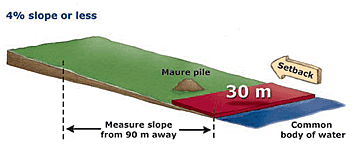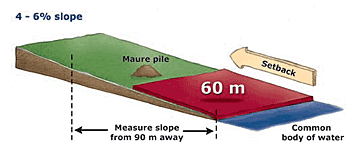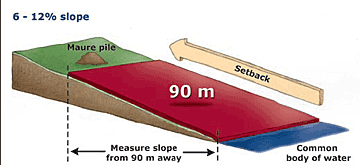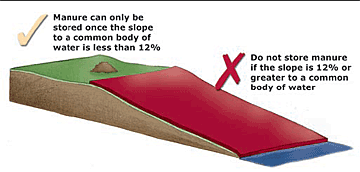| | Key requirements | Manure storage and application | Manure application and incorporation | Soil nitrogen and salinity limits | Nutrient management plans | Seasonal feeding and bedding sites (wintering sites) and livestock corrals | Record keeping and soil testing | Enforcement process
The purpose of AOPA is to ensure that the province’s livestock industry can grow to meet the opportunities presented by local and world markets in an environmentally sustainable manner.
Manure management requirements for all livestock operations in Alberta are outlined in the Agricultural Operation Practices Act (AOPA) and associated regulations. While this legislation focuses more on confined feeding operations* (e.g. feedlots, backgrounder operations, etc.), there are implications for cow/calf producers.
AOPA does not regulate livestock in a grazing situation. However, cow/calf operations are required to follow the regulations for manure collection, as well as manure application and storage setback distances from neighbours and common bodies of water.
For more information on AOPA, please refer to the contacts at the end of this document.
Terms the reader needs to know:
- A common body of water* refers to the bed and shores of rivers, streams, creeks (both permanent and intermittent) and canals as well as reservoirs, lakes, marshes and sloughs that are shared by or common to more than one landowner.
- Manure* includes livestock excreta, straw, other bedding material, litter, soil, and feed in the manure. Composted manure has the same requirements as manure.
* Terms used in this publication have been simplified to make it easier to read. Complete definitions are found in Section 1 of the legislation.
Key Requirements
Managing manure is an integral part of protecting the environment (surface water and groundwater) and minimizing nuisance effects to neighbors. Cow/calf producers should be familiar with the requirements for the following:
- manure storage
- manure application
- wintering sites and corrals
- record keeping and soil testing
Manure Storage and Application
The requirements may vary depending on the type of manure storage used. Short-term solid manure storage sites are generally used to store manure collected from locations where manure has accumulated before it can be spread on the land. A short-term solid manure storage site can only be used for an accumulated total of seven months within a three-year period regardless of the amount of manure stored. In other words, manure can be stored in the field for up to seven consecutive months at one location, and then the site cannot be used for the next two years and five months.
If 500 tonnes or more of manure are stored for more than seven months in a calendar year on the same spot, the site used must meet the requirements in the legislation for a manure storage facility and a permit must be obtained from the Natural Resources Conservation Board (NRCB) for the manure storage. Feedlot pens must also meet the requirements for manure storage facilities, not short-term storage sites. Note: The average cow/calf pair produces about three (2.95) tonnes of manure per year (depending on the amount and type of bedding used).
Short-term solid manure storage sites must be located at least:
- 150 metres (m) from a residence or occupied building that the producer does not own
- 100 m from a spring or water well
- 1 m above the water table
- 1 m above the 1-in-25 year maximum flood level
If the land slopes towards a common body of water, the setback distances in the following table and figures must be observed for short-term manure storage. The same setbacks are required for manure application on forage, direct-seeded crops and frozen or snow-covered land.
Setback distances for manure application and short-term storage
| Average slope within 90 metres of a common body of water | Setback distance required from the common body of water |
| 4% or less | 30 m |
| Greater than 4% to less than 6% | 60 m |
| 6% or greater, but less than 12% | 90 m |
| If the slope is 12% or greater, do not apply or store manure on the land. Once the slope is less than 12%, manure can be applied or stored. |
Manure application and short-term storage setbacks on land with less than 12% slope



Manure application and short-term storage setbacks on land with 12% slope or greater

Manure Application and Incorporation
Anyone applying manure to land must take into account the incorporation requirements, soil nitrogen and salinity limits, setback distances to water and runoff risks. Solid manure can only be applied to arable land and must be:
- applied at least 30 m from a water well or a common body of water (when applied to cultivated land)
- incorporated within 48 hours of application, except when applied on forage, direct-seeded crops, frozen or snow-covered land
- applied at least 150 m from a residence or occupied building that is not owned by the producer if the manure is not incorporated
- applied according to the setback distances in the table and figures above when not incorporating manure and if the land slopes towards a common body of water
Soil Nitrogen and Salinity Limits
The regulation sets soil nitrate-nitrogen and salinity limits for manure application. These limits can only be exceeded if a producer has a nutrient management plan that has been approved by the NRCB.
The soil nitrate-nitrogen limits are set according to various farming methods, soil groups, soil textures and the depth to the water table. The following table specifies the nitrate-nitrogen levels that may not be exceeded in the top 60 cm of soil after manure application.
Nitrate-nitrogen limits in soil
(Standards and Administration Regulation, Schedule 3, Table 3)
| Farming method | Soil group | Sandy (>45% sand and water table <4 m) | Sandy (>45% sand and water table > 4 m) | Medium and fine textured soils |
 | Brown | 80 kg/ha
(75 lb/ac) | 110 kg/ha
100 lb/ac) | 140 kg/ha
(125 lb/ac) |
| Dryland | Dark Brown | 110 kg/ha
100 lb/ac) | 140 kg/ha
125 lb/ac) | 170 kg/ha
(150 lb/ac) |
 | Black | 140 kg/ha
125 lb/ac) | 170 kg/ha
150 lb/ac) | 225 kg/ha
(200 lb/ac) |
 | Grey Wooded | 110 kg/ha
100 lb/ac) | 140 kg/ha
125 lb/ac) | 170 kg/ha
(150 lb/ac) |
| Irrigated | All groups | 180 kg/ha
160 lb/ac) | 225 kg/ha
200 lb/ac) | 270 kg/ha
(240 lb/ac) |
Note: To convert kg/ha into lbs/ac, divide the kg/ha by 1.1 (e.g. 110 kg/ha / 1.1 = 100 lbs/ac)
To ensure the salts in manure do not affect plant growth, the regulations specify that manure must not be applied to soils that have an electrical conductivity (salinity) greater than 4 deciSiemen per metre (dS/m) from the top 0 cm to 15 cm of the soil. The regulations also specify that manure should not be applied at levels that would increase the soil salinity (after manure is applied) by more than 1 dS/m from a soil depth of 0 cm to 15 cm.
Nutrient Management Plans
Nutrient management plans are not mandatory for everyone who applies manure. Under AOPA, an approved nutrient management plan is required if a person wants to exceed the nitrate-nitrogen or salinity limits when applying manure. The NRCB can approve a nutrient management plan for applying manure in excess of the limits if the NRCB is satisfied that implementing the nutrient management plan will not adversely affect the soil or the environment.
Seasonal Feeding and Bedding Sites (Wintering Sites) and Livestock Corrals
Seasonal feeding and bedding sites (wintering sites) and livestock corrals must be located at least 30 m away from a common body of water to reduce runoff risks.
If a corral or wintering site is closer than 30 m, one of two options must be implemented:
Option 1: An interceptor (e.g. berm or ditch) must be constructed between the site and the water to divert runoff from the site away from the water.
or
Option 2: Manure and bedding accumulated at the site must be moved to an appropriate manure storage facility or area before runoff occurs.
Record Keeping and Soil Testing
Each person who handles 500 tonnes or more per year of manure must keep manure management records for five years and must conduct soil tests on the land where the manure is to be applied. The manure must also be applied according to the soil nitrogen and salinity limits in the legislation or an NRCB approved nutrient management plan.The soil test results for land on which manure is applied must not be older than three years, except for soil texture, which is a one-time analysis.The record keeping requirements do not apply to manure produced by livestock when they are grazing.
Records required:
- soil test results
- amount of manure produced or handled
- name and address of each person who receives or applies manure, as well as applicable dates
- land location where manure is applied
- application rates of manure and fertilizer
Further details and examples of record keeping forms are available from the contacts listed at the end of this publication.
Enforcement Process
An inspection of a livestock facility by the NRCB can be triggered if the NRCB receives a complaint. NRCB inspectors typically look at potential risks to the environment or problems related to manure handling, storage and application. If a problem is found, inspectors will work with operators to resolve the situation. When determining the appropriate enforcement response, inspectors will consider the significance of any non-compliance as well as the risk to the environment and the operator’s willingness to address the issue voluntarily.
For more information, contact:
(Dial 310-0000 to be connected toll-free)
Alberta Agriculture and Rural Development
Lethbridge 403-381-5885
Red Deer 403-755-1475
Morinville 780-939-1218
Ag-Info Centre 310-FARM (3276)
Publications 1-800-292-5697
Natural Resources Conservation Board
Lethbridge 403-381-5166
Red Deer 403-340-5241
Morinville 780-939-1212
Fairview 780-835-7111
Response Line 1-866-383-6722
DISCLAIMER: This document is not intended as legal advice, but as an interpretive document to the Agriculture Operation Practices Act and Regulations.
Source: Agdex 096-6. Revised March 2007. |
|